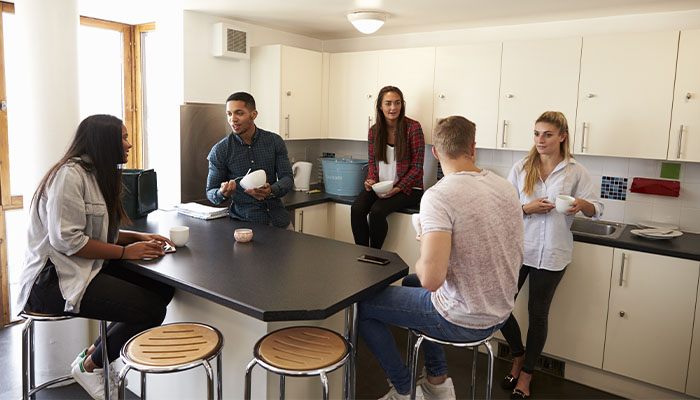Landlords looking to make more money from their portfolio often consider converting a rental property into an HMO: a house in multiple occupation is a dwelling rented out to three or more people who are not related.

© Monkey Business Images / Shutterstock.com
A HMO comprises individual living space for each occupant and several shared areas including the bathroom, kitchen, utility room and sometimes a lounge or other living area. There are around 500,000 houses in multiple occupation in England and Wales alone, according to government statistics.
A landlord planning to rent out an HMO in the UK needs a licence from the local council. When the property is defined as an HMO, the licence will last for five years. The landlord will then need to update it.
A number of specific criteria relate to being an HMO landlord, including having an appropriate number of occupants and sufficient room space. The landlord must keep up-to-date with the licence and legislation, as the financial penalties for renting out an unlicensed HMO are severe.
Who typically would rent an HMO?
Research shows there are four main types of HMO tenants: students traditionally rent HMOs for the sense of community and to keep living costs down. While student “digs” 30 years ago weren’t expected to be particularly classy, all this has changed today and there are higher expectations.
Students often come as a group of friends, especially those who have moved out of their first-year student halls of residence and want to live together. This can make it easier for landlords, as the house dynamic tends to organise itself.
The second group comprises professional tenants who have just got a graduate job in a new area. They are often working for the first time since university, so are used to living in HMO accommodation and know what to expect. They will fit into the household easily as a result.
The third group, “blue collar” workers, usually work in a labouring job, such as a factory, or may be immigrant workers who have relocated from Europe to the UK. They tend to work hard and are out for long hours earning – they generally tend to keep their head down and don’t create any problems for landlords.
Those claiming state benefits, such as unemployment or disability benefits from the Department of Work and Pensions, or housing benefit from the local council, are the fourth main group The landlord can have the rent paid directly into their own bank account under various circumstances, so it is guaranteed to be paid on time.
What are the benefits of converting?
Converting to an HMO provides landlords with increased revenue, compared with a single rented property for one person or one family. Research has revealed the average rent yield for an HMO is 7.5% – an impressive 1.5% higher than the average yield for a single property investment.
There is more security for the landlord, because they aren’t reliant on a single tenant or one household for income. If one tenant falls behind with the rent, or if someone leaves and their room is vacant, the landlord will still have rent coming in from the other occupants until the situation is resolved.
There can also be tax benefits for HMO landlords with a limited company, who can claim back 100% of their mortgage interest, releasing savings through Capital Gains tax relief.
Currently, there’s a higher demand for HMOs than regular rental properties. Landlord organisations have reported an upward trend during and after the Covid pandemic, as renters are trying to save money by living in shared properties.
The latest data shows an average HMO in the UK can generate a cashflow of between £700 and £1,400 per calendar month and a ROI of up to 20% for the landlord. This would be hard to achieve in many other business sectors.
When one tenant leaves, it’s necessary to decorate only their individual room, rather than the whole property.
What do you need to do to convert a property into an HMO?
If you decide to go ahead and convert a rental property into an HMO, the first step should be getting your licence. Read our guide to HMO licences for information on how to go about this.
You will also need to consider room sizing, as the law dictates the minimum requirements to fulfil tenants’ needs. The minimum bedroom sizes for licensed HMOs are as follows: a bedroom housing one adult must measure at least 6.51 square metres. A bedroom for two adults must be 10.22 sq metres, while a bedroom for a child should be no smaller than 4.64 sq metres.
Purchasing HMO furniture
High quality, durable furniture that will last through multiple tenancies is the best option when furnishing your HMO.
Many landlords choose a professional supplier of HMO furniture packs, as this can have multiple benefits. Not only can it be a more cost-effective solution to furnishing all the rooms, but it is also more convenient. The landlord doesn’t have the hassle and expense of buying suitable furniture from different suppliers and arranging deliveries, as it’s all done for you.
